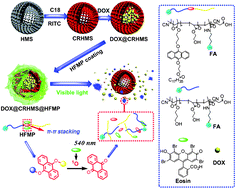a Jiangsu Key Laboratory of Advanced Functional Polymer Design and Application, College of Chemistry, Chemical Engineering and Materials Science, Soochow University, Suzhou, 215123 China
b State Key Laboratory of Treatments and Recycling for Organic Effluents by Adsorption in Petroleum and Chemical Industry, Suzhou, 215123 China
c Medical College of Radiation Medicine and Protection, Soochow University, Suzhou, China
J. Mater. Chem. B 2013, 1, 4628-4636.
A core–shell nanocomposite based on photo-degradable polymer coated hollow mesoporous silica nanoparticles (HMS) was successfully prepared for targeted drug delivery and visible-light triggered release, as well as fluorescence cell imaging. The HMS nanoparticles were first modified by the long-chain hydrocarbon octadecyltrimethoxysilane (C18) and fluorescent agent Rhodamine B isothiocyanate (RITC), and then encapsulated by a photodegradable amphiphilic copolymer via a self-assembly process. The obtained nanocarrier showed a high drug loading content due to the hollow core and mesopores of the HMS and could target folic acid receptor over-expressed tumor cells efficiently for conjugating folic acid (FA) in the amphiphilic polymer. The drug release could be triggered by the irradiation of green light (500–540 nm) due to the photodegradation of amphiphilic copolymer coated on the HMS. Furthermore, the targeted drug delivery and controlled release processes could be tracked by fluorescence imaging for the doping of RITC on the HMS. The In vitro results suggested that a smart visible light responsive drug delivery system was successfully prepared for the potential applications of cancer diagnosis and therapy.

链接: //pubs.rsc.org/en/content/articlelanding/2013/tb/c3tb20922a#!divAbstract